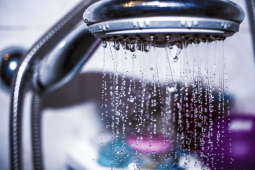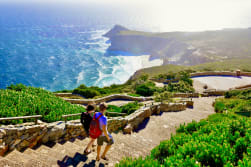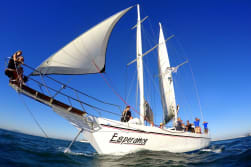How City Sightseeing Saves Water
28 February 2018 | Alyx Carolus The ongoing drought that has affected the Western Cape has had a severe impact on its residents and industries. However, South Africa is a water-scarce country and being conscious of water usage should be a part of our day-to-day activities, drought or no drought.
At City Sightseeing, there’s been a strong commitment to save water and come up with long-term solutions to ensure that water usage remains at a minimum. Cape Town is now under strict level 6B water restrictions, which allow 50 litres of water per person, per day. These restrictions are in place to ensure that we don’t reach Day Zero and eventually run out of water.

How is City Sightseeing helping to save water?
Even before the news of stricter water restrictions broke, there has been a need to create more water-efficient practices. In recent months, the CSS head office in Paarden Eiland made the move to invest in a well-point borehole on the premises.
City Sightseeing South Africa CEO Claus Tworeck shares some valuable details about the process: “Our head office, being so close to the sea, made it viable to dig a well point that is fed with seawater. We then installed a desalination plant that runs our entire head office; we could be 100% off the grid when it comes to water usage.”
Claus Tworeck introduces the desalination plant
Desalination plants extract clean, drinkable water from saline water. The well-point water is pumped into a tank, from where it goes into the plant. The water then undergoes a water-purification process called reverse osmosis, which removes ions and molecules to create consumable, drinkable water.
Beyond installing water-efficient technology, City Sightseeing has also significantly lowered its overall water usage. At City Sightseeing, Tworeck explains that the desalination plant helps provide all drinking water, as well as water for other everyday uses like flushing toilets.
Flush only when necessary to help ease water usage.
Tourism operators in and around South Africa all need to adapt the way they use natural resources. Water is essential to our everyday lives and being strict about usage is the new normal. City Sightseeing is making a concerted effort to implement global best practice regarding water-conservation methods and to create alternative resources beyond using municipal water.
“Even when the drought is over, I hope most of these measures will stay in place,” Tworeck says. “Global warming is a reality and these little initiatives will go a long way to making the region more sustainable.”

Small changes with big results
While citizens have been encouraged to utilise grey water from showers, sinks and washing-machine cycles, businesses often have to incorporate other water-saving methods. CSS has put measures put into place like changing hand-basin tap heads.
“It’s gone from between six and nine litres a minute, to around 0.9 litres a minute, which is just a fine spray that comes out of the taps,” Tworeck says.
Additional steps include putting bricks into toilet cisterns, which allows for the same amount of water pressure when flushing but with less water usage.
“We’re now down to about 3.5 litres of water per flush,” Tworeck says, “and even though we’re using desalinated water, we’ve really tried to limit our water consumption.” Toilets can use anywhere from six to 13 litres per flush, depending on the model and make.
The showers on the premises have been fitted with low-flow showerheads, which reduces consumption to three litres per minute. There are also buckets to catch the grey water. This is perfect for a quick 90-second shower during the current drought.
Install low-flow showerheads to lower the water pressure per minute. Another innovative practice by City Sightseeing is the harvesting of water from the air conditioner. This is used by staff for handwashing, along with mopping and cleaning the buses.
The easily recognisable red buses are on a once-a-week washing schedule to help ease the pressure of using water during the crisis.
These practices have been implemented across the City Sightseeing tour offices. The harvested water from air conditioners is also used to water plants around the various offices.
Staff are fully on board to assist in implementing these simple changes and are using these practices at home, too.
The results
Prior to the installation of the desalination plant, the CSS head office was using about 8 000 litres of municipal water per day.
With the installation of the desalination plant, the usage of municipal water has dropped to around 20 litres of water per day. Given that at any time there are about 40 staff in the building, with many more passing through in the morning and afternoon, that’s even less than the daily 50-litre allowance that the City of Cape Town has implemented.
Capetonians are actively trying to avoid Day Zero and it can only be done through the collaborative efforts of tourism operators, local government, residents and tourists.

Going greener is the future
Water isn’t the only resource that can be misused, and beyond the installation of the desalination plant, there have been changes to energy usage as well. City Sightseeing has made the shift towards installing solar-energy panels at its head office. This will assist in lowering its carbon footprint and being more energy efficient in the future. The head office is producing 80% of the energy it needs through solar energy.
Install solar panels for cleaner energy consumption and to decrease your electricity bill. Other ongoing initiatives include banning plastic straws in the tour offices, along with providing customers with paper bags for their purchases.
The tourism industry has to begin implementing ideas that focus on cutting down on energy and water usage, and helping the environment flourish.
To help lower its overall carbon footprint, City Sightseeing has started investigating electric double-decker buses as a viable option in the future. While South Africa doesn’t have the necessary infrastructure to implement this immediately, this is something that could develop in the next three to four years.
How can visitors help?
We urge tourists to keep coming to our beautiful city, while being mindful of the drought. City Sightseeing offices have signage up explaining the current water crisis to tourists, while the audio commentary for the Red and Blue tour routes also mentions the drought.
Tworeck explains: “Once travellers are here, they just need to be mindful that water is a scarce resource. It’s not a case of not consuming water, it’s about not wasting it.” Where can you get your City Sightseeing tickets?
Purchase your tickets online or from stop 1,5 or 8. Alternatively, you can buy tickets from your bus drivers. We look forward to seeing you on board soon!







